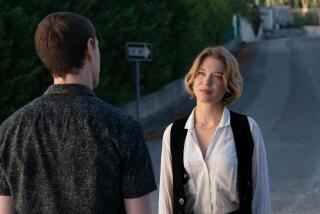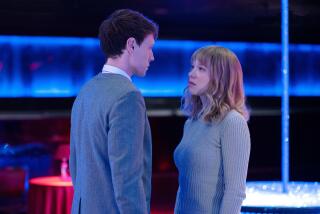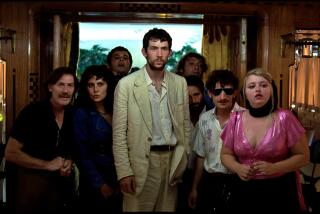Review: Al Pacino interprets Oscar Wilde in companion pieces ‘Wilde Salomé’ and ‘Salomé’
On the heels of their recent showings as part of an extensive Al Pacino retrospective at New York City’s Quad Cinemas comes the long-delayed theatrical premiere of a pair of Pacino-helmed, stage-centric films, “Wilde Salomé” and its follow-up, “Salomé.”
This nichey, experimental duo are companion pieces for sure, so they are best seen — and discussed — in tandem and in order, even if that wasn’t necessarily Pacino’s original raison d’etre when he cobbled these projects together more than a decade ago. But what exactly was his purpose?
Pacino’s way into this ambitious endeavor was, at least initially, a fascination with Victorian-era poet and playwright Oscar Wilde and his provocative play “Salomé,” a Biblically-inspired tragedy that was banned in Britain just before its 1892 debut. The play eventually premiered in Paris in 1896, at which time Wilde, who was gay, was serving a two-year prison sentence for “gross indecency.” (“Sunset Boulevard” fans will remember “Salomé” as the unlikely basis for Norma Desmond’s would-be “comeback” picture.)
“It’s gonna look a lot like I don’t know what I’m doing — because I don’t,” says Pacino at the start of “Wilde Salomé,” a captivating, enjoyable, often edifying documentary written and directed by Pacino that proves the “Serpico” and “Scent of a Woman” star is perhaps more creatively strategic and capable here than he may have thought.
The film largely tracks a period in 2006 when Pacino performed in a production — actually a developed staged-reading in modern dress — of “Salomé” (directed by veteran actress and theater director Estelle Parsons) at UCLA’s Wadsworth Theatre, while he was also making a movie documenting the mounting of said show, concurrently shooting a narrative film version of the play and exploring the fraught life and career of Oscar Wilde.
Pacino bites off an awful lot here, yet, as our puckish, ebullient and, later, prickly guide on this kaleidoscopic journey, he manages to present an intriguing and passionate view of artistic risk and reward.
Make that potential reward as it turned out that the Wadsworth run of “Salomé,” in which Pacino played Herod, king of Judea, opposite then-newcomer Jessica Chastain in the title role (Kevin Anderson and Roxanne Hart also appeared) earned mixed reviews — in his pan, Times theater critic Charles McNulty dubbed Pacino’s turn “wacky” and “loopy” — and incurred the wrath of some theatergoers for its spartan, “interpretative” approach. (Steep ticket prices apparently didn’t help.)
Meanwhile, Pacino is plagued by budget-conscious producers and a stingy shooting schedule as he films an adaptation of the “Salomé” play. Behind-the-scenes tensions and bits of on-set urgency compellingly evoke “Project Greenlight”-like tumult with Pacino, ever the showman here, unafraid to present himself as a producer’s semi-worst nightmare.
Pacino schlepping cast and crew members out to the Mojave Desert to shoot a series of emblematic bits (there’s a camel!) to conjure up the mood and setting of “Salome,” has a near-satirical sense; you can practically feel the eye rolls.
Still, there’s clearly a method to Pacino’s “madness.” For better or worse, it’s called vision.
Not unlike his approach to examining William Shakespeare in his 1996 documentary “Looking for Richard,” Pacino hops the globe (London, Dublin, Paris, New York) to enlighten himself — and the viewer — about the world of Oscar Wilde and gain a deeper understanding of how “Salomé” came to be.
There are also brief chats with such notables as Tom Stoppard, the late Gore Vidal, Tony Kushner, Bono and Wilde’s grandson, Merlin Holland, who all astutely weigh in on Wilde and his work.
Pacino’s second film, simply titled “Salomé,” is the result of his efforts portrayed in “Wilde Salomé” to transfer Parsons’ stage version of the play to the screen. And, despite bits of duplication, you’ll be better off for having seen the documentary first, based on the insight, context and history it provides about Wilde’s often dazzling piece.
That cinematically, Pacino’s “Salomé” is ultimately little more than a well-shot and edited theater piece — stagebound and focused on the cast’s compelling faces and Wilde’s vivid text — is as much a practical matter (time, money) as, it turns out, a creative plus.
The feature’s visual simplicity ends up countering the play’s more florid, flamboyant elements, keeping the lean but intense story more centered and accessible. To quote the Bard, “The play’s the thing.”
Chastain, in what was then her first feature film, shows the radiance and star power she would soon exhibit on a regular basis. With her ruby lips, translucent skin and mane of flame-red hair, she plays the petulant and privileged young seductress Salomé with great vigor and fearsome self-possession. Her “Dance of the Seven Veils,” performed at the behest of her smitten stepfather, King Herod (Pacino), is mesmerizing.
Pacino’s Herod, who’s married to Herodias (a steely Hart), Salomé’s mother and the widow of the king’s brother, is a singular creation: playful, taunting, persuasive, a bit fey. Let’s just say, Pacino’s trying stuff and he’s fun to watch.
hroughout, Pacino and Hart remain mostly seated in plush red chairs — thrones? — as the story of Herod’s creepy infatuation with Salomé; Salomé’s unrequited attraction to an imprisoned Jokanaan, a.k.a. John the Baptist (Anderson, fierce); and her bloody revenge against him, unfolds almost entirely on a muted, spare, yet eminently workable set.
The “Salome” film proves a chilling and watchable look at lust, power, reprisal and decadence that, along with “Wilde Salome,” validates Pacino’s obsessive interest in Wilde’s still-resonant play while also giving movie and theatre lovers a candid and involving window into the artistic process.
------------
‘Wilde Salomé’
Rating: R, for some language, nudity and violent images
Running time: 1 hour, 28 minutes
-------------
‘Salomé’
Rating: R, for some nudity and disturbing bloody images.
Running time: 1 hour, 21 minutes
Playing: Both films at Laemmle Monica Film Center, Santa Monica
See the most-read stories in Entertainment this hour »
Movie Trailers
More to Read
Only good movies
Get the Indie Focus newsletter, Mark Olsen's weekly guide to the world of cinema.
You may occasionally receive promotional content from the Los Angeles Times.






